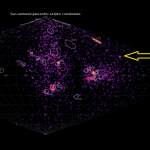2020 URSIDS REPORT:
There was a possibility that the 2020 Ursids might produce a series of predicted outbursts during the night of December 21/22.
The weather appeared hopelessly cloudy within driving distance, but I decided to venture out anyway with the 2 hours drive to the North Frontenac Dark Sky Preserve Site late at night, in a last ditch attempt to catch a possible clear break. It was a long shot. I arrived at the site near 1:30am EST (local time), and the sky was about 95% cloudy (not much to be seen at all). I went ahead and setup my cameras, as the satellite image showed a small hole approaching in the west. It was very mild at 0C, and calm. Unlike the Geminids session, I opted to setup at the south end of the parking lot to gain a better view of the northern sky. In fact, all of the horizons were great from that spot, except for a low tree line in the west.
Just before 2am, the sky showed a gradual sign of clearing trend to the west — I could see a few more stars. By 2:10am, I could see the Big Dipper, and stars down to mag +3 in the south-west. Ursa Minor became visible. It took until 2:50am for the sky to clear up just enough (20% clouds) to attempt signing-on for a meteor watch. The sky transparency was poor with a limiting magnitude of only 5.6. I was only able to observe for 25 minutes before it clouded over again. During that time, I saw two meteors (a December Leonis Minorid and a sporadic). I was viewing far past the predicted timing of possible Ursids outbursts, and as such, none were seen.
The 2020 Ursids did in fact produce above average around 5 UT (midnight EST) as reported by the CAMS network in the US. No sensational outburst, but a significant number of Ursid orbits. https://www.emeteornews.net/2020/12/22/many-ursid-orbits-for-cams-networks-in-the-us/
December 21/22 2020, 07:50-08:15 UT (02:50-03:15 EST)
Location: North Frontenac Dark Sky Preserve Site, Ontario, Canada
(Long: -76 deg 56’ 23” West; Lat: 44 deg 55′ 04″ North)
IMO session: https://www.imo.net/members/imo_vmdb/view?session_id=82755
Observed showers:
Anthelion (ANT) – 06:44 (101) +23
December Monocerotids (MON) – 07:10 (108) +07
alpha Hydrids (AHY) – 07:50 (117) -06
Geminids (GEM) – 08:02 (121) +31
sigma Hydrids (HYD) – 09:03 (136) -00
December Leonis Minorids (DLM) – 10:49 (162) +30
Comae Berenicids (COM) – 12:01 (180) +15
December chi Virginids (XVI) – 13:02 (195) -13
December sigma Virginids (DSV) – 13:46 (206) +05
Ursids (URS) – 14:22 (215) +76
07:50-08:15 UT (02:50-03:15 EST); 1/5 trans; F 1.25; LM 5.60; facing NW80 deg; teff 0.42 hr
DLM: one: +2
Sporadics: one: +4
Total meteors: Two
QUICK REPORT ON THE 2021 QUADRANTIDS:
I did not have any luck with the weather for the 2021 Quadrantids peak, however the sky partly cleared briefly at the end of the night at my east-end Ottawa home. In a period of ten minutes between 10:35-10:45 UT (05:35-05:45 EST), viewing from my deck (facing the south-east sky), with a 75% waning gibbous moon, 50% clouds, and a limiting magnitude of only about +4.5, I saw 14 Quadrantids!! The brightest ones were mag 0. These rates (better than one per minute) were impressive in the poor sky conditions. The Quadrantids had a strong double-peak structure as reported by radio observations:
https://www.emeteornews.net/2021/01/11/quadrantids-2021-with-worldwide-radio-meteor-observations/


